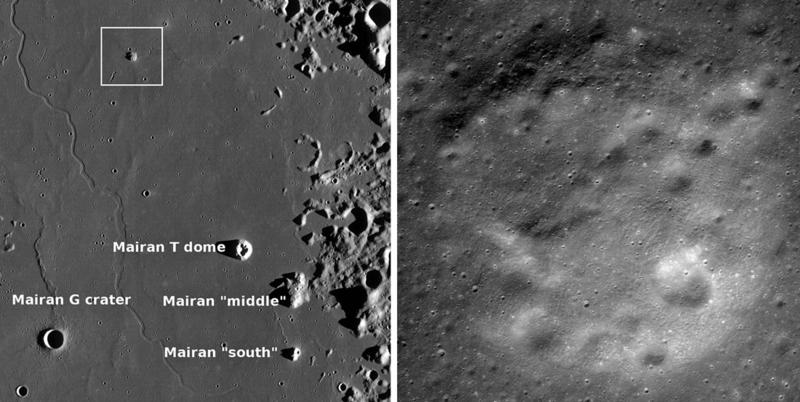Difference between revisions of "April 24, 2013"
| (7 intermediate revisions by the same user not shown) | |||
| Line 1: | Line 1: | ||
__NOTOC__ | __NOTOC__ | ||
=A Dome of a Different Color= | =A Dome of a Different Color= | ||
| + | <!-- Start of content --> | ||
<!-- ws:start:WikiTextHeadingRule:0:<h1> --> | <!-- ws:start:WikiTextHeadingRule:0:<h1> --> | ||
<!-- ws:start:WikiTextLocalImageRule:6:<img src="/file/view/LPOD-Apr24-13.jpg/425885482/800x402/LPOD-Apr24-13.jpg" alt="" title="" style="height: 402px; width: 800px;" /> -->[[File:LPOD-Apr24-13.jpg|LPOD-Apr24-13.jpg]]<!-- ws:end:WikiTextLocalImageRule:6 --><br /> | <!-- ws:start:WikiTextLocalImageRule:6:<img src="/file/view/LPOD-Apr24-13.jpg/425885482/800x402/LPOD-Apr24-13.jpg" alt="" title="" style="height: 402px; width: 800px;" /> -->[[File:LPOD-Apr24-13.jpg|LPOD-Apr24-13.jpg]]<!-- ws:end:WikiTextLocalImageRule:6 --><br /> | ||
| − | <em>images from [http://www.lroc.asu.edu/news/index.php?/archives/748-The-Fourth-Mairan-Dome.html#extended | + | <em>images from [http://www.lroc.asu.edu/news/index.php?/archives/748-The-Fourth-Mairan-Dome.html#extended LROC Featured Images] (NASA/GSFC/Arizona State University)</em><br /> |
<br /> | <br /> | ||
| − | Along the eastern shores of northern Oceanus Procellarum is the slightly famous Mairan T dome. It is steep-sided with large craters on top, a most unusual lunar dome that has long been recognized as a red spot, and presumably constructed of more silica-rich lavas than most other lunar volcanics. Two other nearby and less spectacular hills are also red spots and they have been unimaginatively called Mairan middle and south. Now data from the LRO Diverer infrared radiometer has [http://onlinelibrary.wiley.com/doi/10.1029/2011GL049548/abstract | + | Along the eastern shores of northern Oceanus Procellarum is the slightly famous Mairan T dome. It is steep-sided with large craters on top, a most unusual lunar dome that has long been recognized as a red spot, and presumably constructed of more silica-rich lavas than most other lunar volcanics. Two other nearby and less spectacular hills are also red spots and they have been unimaginatively called Mairan middle and south. Now data from the LRO Diverer infrared radiometer has [http://onlinelibrary.wiley.com/doi/10.1029/2011GL049548/abstract determined] that these three features plus a fourth one to the north (Mairan northwest), are indeed composed of silica-rich volcanic rocks. The magmas that erupt such rocks are considered to be evolved because on Earth they are are not primary magmas coming directly from the mantle - as ocean floor basalts are - but modified from a basic basalt by the intermixing with materials of other compositions or by a basalt continually becoming more silicic by separation of crystallized parts of a magma from the still melted parts. [http://www.lpi.usra.edu/meetings/lunarhighlands2012/pdf/9011.pdf Neither] of these processes perfectly explains how lunar silicic magmas evolved. But from the point of view of an observer, it doesn't matter. Here are more obervational targets, made fascinating by the fact that they are a bizarre rock type that can't be easily explained. The new Mairan northwest dome is about 180 m high and 3.2 km wide - it should be detectable when the illumination is low in the area.<br /> |
<br /> | <br /> | ||
| − | <em>[mailto:tychocrater@yahoo.com | + | <em>[mailto:tychocrater@yahoo.com Chuck Wood]</em><br /> |
<br /> | <br /> | ||
<strong>Related Links</strong><br /> | <strong>Related Links</strong><br /> | ||
| − | Rükl plate [ | + | Rükl plate [https://the-moon.us/wiki/R%C3%BCkl_9 9]<br /> |
| − | <em>[ | + | <em>[[21st Century Atlas of the Moon|21st Century Atlas]]</em> chart 20.<br /> |
<br /> | <br /> | ||
| + | <p><b>Yesterday's LPOD:</b> [[April 23, 2013|625 mm]] </p> | ||
| + | <p><b>Tomorrow's LPOD:</b> [[April 25, 2013|Remembrance of Basins Past]] </p> | ||
<hr /> | <hr /> | ||
| + | {{wiki/ArticleFooter}} | ||
Latest revision as of 08:22, 28 October 2018
A Dome of a Different Color

images from LROC Featured Images (NASA/GSFC/Arizona State University)
Along the eastern shores of northern Oceanus Procellarum is the slightly famous Mairan T dome. It is steep-sided with large craters on top, a most unusual lunar dome that has long been recognized as a red spot, and presumably constructed of more silica-rich lavas than most other lunar volcanics. Two other nearby and less spectacular hills are also red spots and they have been unimaginatively called Mairan middle and south. Now data from the LRO Diverer infrared radiometer has determined that these three features plus a fourth one to the north (Mairan northwest), are indeed composed of silica-rich volcanic rocks. The magmas that erupt such rocks are considered to be evolved because on Earth they are are not primary magmas coming directly from the mantle - as ocean floor basalts are - but modified from a basic basalt by the intermixing with materials of other compositions or by a basalt continually becoming more silicic by separation of crystallized parts of a magma from the still melted parts. Neither of these processes perfectly explains how lunar silicic magmas evolved. But from the point of view of an observer, it doesn't matter. Here are more obervational targets, made fascinating by the fact that they are a bizarre rock type that can't be easily explained. The new Mairan northwest dome is about 180 m high and 3.2 km wide - it should be detectable when the illumination is low in the area.
Chuck Wood
Related Links
Rükl plate 9
21st Century Atlas chart 20.
Yesterday's LPOD: 625 mm
Tomorrow's LPOD: Remembrance of Basins Past
COMMENTS?
Register, Log in, and join in the comments.



